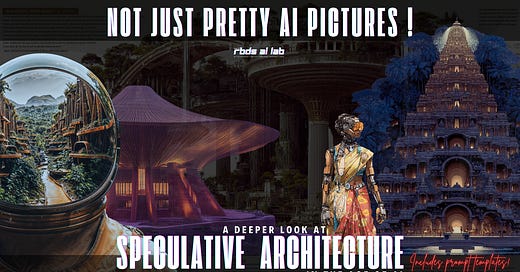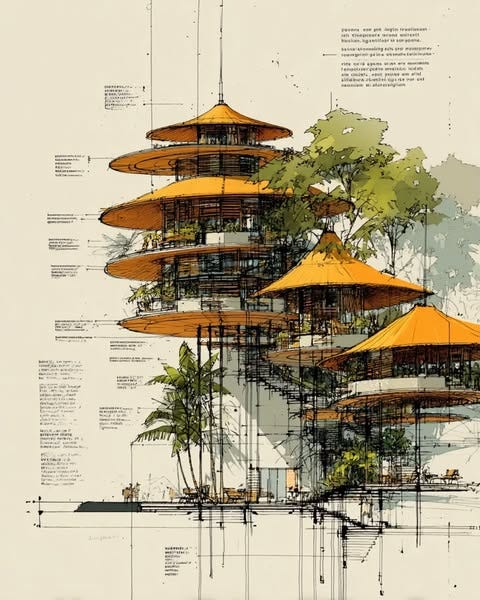Not Just Pretty AI Pictures: A Deeper Look at Speculative Architecture in the Age of AI
An inside look at our approach: from tools and prompt crafting to AI-driven sketches, why designing futures matters long before we build them.
Where Do These Dreams Come From?
Picking up the thread from last week, we opened a wide lens on speculative architecture, questioning not only how we build, but also why we build at all. From unsettling cityscapes to future farm imaginaries, we explored how fiction, design, and AI collide to shape narratives that traditional practice often overlooks. If you missed it, read Part 1 here.
Many of you reached out with questions: Are these images real? What is the project? How long does it take? What tools do we use? This week, we explore these not with a quick FAQ, but by deepening the investigation that gave rise to these sketches.
Not Random. Not Rendered. These images aren’t random. They aren’t stock renders. They’re neither final visuals for client presentations nor casual AI doodles. What you see on our Instagram and in this post are slices of thought. They’re byproducts of an iterative speculative process involving LLMs like ChatGPT for narrative framing, Midjourney for atmospheric provocations, and a back-and-forth that tests the architectural idea itself. Each output is a probe into how an idea might adapt under different lights, cultural, ecological, and technological.
So What Are These Projects?
Are they commissions? Mostly not. They’re closer to research fiction. Think of them as architectural thought experiments that let us explore how buildings and settlements might emerge if we prioritized biodiversity corridors or ritual spaces woven with canopy systems.
For example, these aren’t tied to Coorg or Tamil Nadu. They’re speculative studies, temples that bloom like forests, towers layered with living canopies, coastal clusters that read like hybrid blueprints and dreams. They’re our way of asking: what might civic or sacred architecture become if we designed from inside ecology, rather than imposing on it? Each is a collision of section drawings, AI-generated atmospheres, and quiet provocations we feed back into our narratives.
How We Do It at RBDS AI Lab
At RBDS AI Lab, we explore Speculative Friction, where urgent ideas meet old traditions through AI. It’s a layered process: prompting LLMs for narrative worlds, using diffusion models for atmospheric sketches, and then looping it all through critique and real references.
Begin Your Own Speculative Loop
Want to try this? Here is a template. This is a scaffold, not a script. Layer them, twist them, break them.
Prompt template for ChatGPT: Narrative + Brief
You are a speculative architect designing a space that provokes reflection. Write a concept for a structure for [insert odd client: e.g., 'extinct birds', 'post-human data rituals'].
Include:
- Its name
- Its purpose beyond utility
- The ritual or behaviour it supports
- The ethical or emotional tension
- The materials and spatial mood (symbolic, not technical)
- The time or world it belongs to
Make it poetic but clear.
Prompt template for Midjourney
Architectural 2D drawings for a (core idea of the project), competition sheet, (type, material, and shape of the building), muted, in a tropical forest plantation, small captions
(With chaos value 10 - 15 and stylise from 250 - 400)
Try it out, and let us know how it goes. Be playful, be critical, mash up worlds we’d never imagine. Send us what emerges, we’d love to see your speculative loops unfold.
Why We Continue to Probe Through Speculation
Because architecture locks resources and intentions for decades. Speculation lets us wrestle with ethical, ecological, and cultural questions while the stakes are still soft. It’s how we pressure-test the narratives that shape our cities, seeing which ideas fracture, which endure, and why some visions matter more than mere novelty.
In the years ahead, as India folds technology into its landscapes, I suspect our built world might look less like a streamlined smart city brochure and more like this image, a pastoral clearing where a futuristic vessel hovers above grazing cattle. It’s awkward, layered, and contradictory. Perhaps that’s exactly what makes it honest.
An astronaut stands amid woven, biophilic habitats that mirror forests more than cities, reflecting an entire valley within the helmet. It’s my way of wondering—will our most advanced settlements end up bringing us back to the forest, only differently dressed?
Send us your questions, and we’ll weave them into the next dispatch. Because the real value isn’t the image or the tool. It’s the friction, the questions, and the unexpected revelations that speculation brings.
I’m Sahil Tanveer of the RBDSai Lab, signing off for the week. I promote, consult, and apply AI for Architects along with my Architecture and Design Studio, RBDS. If you liked this Substack,
You will love my book, DELIRIOUS ARCHITECTURE: Midjourney for Architects. It is a 330-page hardcover showcasing the potential of AI in Architectural Design. It is available on Amazon worldwide.
You can bend your minds with our WhatsApp channel AI IN ARCHITECTURE where we talk about AI and its impact on us and the built environment.
You can consult with us on AI for your architecture studio. We have multiple levels of learning and integration, from a Beginners session to the AIMM Assessment and beyond. Get in touch with us at sahil@rbdsailab.com or check out our page www.rbdsailab.com
I’m talking about AI. Our team is set to visit key cities of India for architectural conferences, Podcasts and exclusive student interactions at architecture schools. We’d love to come over for an engaging meetup, hands-on workshop, or a creative collab. Enquiries to sahil@rbdsailab.com












